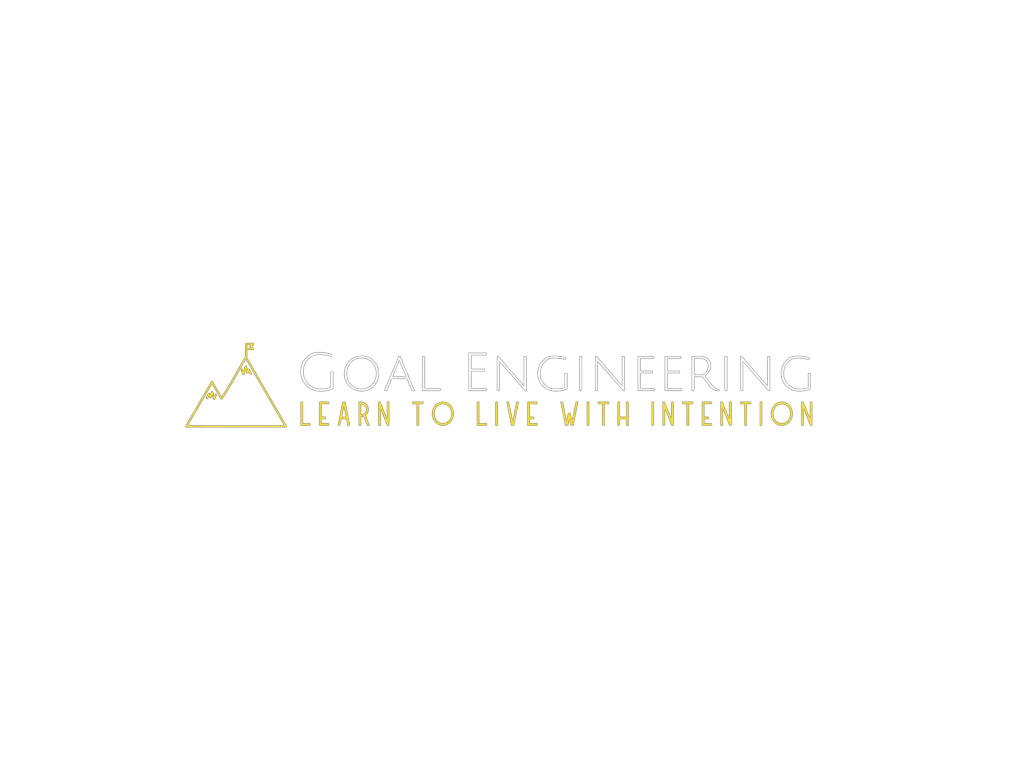Have you ever set a goal and then wondered if it was too shallow? Like, it seemed that this little thing you want to do wouldn’t really last? If you’re wondering how to make your goals more powerful so that they stick, this article is going to help. I’m going to explain the four levels of goals and how to use them to achieve any goal.
These are the 4 levels that you need to apply with each goal to make it effective:
- Action Steps
- Outcomes
- Vision
- Identity
Let’s jump right in and learn about level one.
1. Action Steps
“It is easier to act yourself into a new way of thinking, than it is to think yourself into a new way of acting.” — Millard Fuller
When a person sets a goal like “I’ll go running 3x per week” those are action steps. Although they’re not really a goal on their own, actions are the building blocks of goals, which makes them critical for success.
Actions are the Atomic Habits that James Clear teaches us about. They are the tiny components necessary to make larger events, or outcomes, happen, as we’ll see in a moment.
Without putting in the day-to-day work toward your goals, you’ll never reach them. But without steering them in a purposeful direction of your choosing, you’ll never get where you want to go.
To harness the power of this level of goals, always be asking yourself what’s the best thing you can do each day to reach your goals. In other words, what’s the one thing that if you did every day for the next 12 weeks would guarantee you’d reach your goal?
If, for instance, you want to lose weight, you might try running 3x per week to start. Maybe that doesn’t work, so you try something different until you figure out what does.
Usually, action steps stem from an outcome you decide you want to have, like becoming healthy or growing your income. But you can still realize their power if you start with action steps by asking yourself “why do I want to do this?” and “what outcome do I seek?”
More on that later. For now, it’s time to get to level two.
2. Outcomes
“However beautiful the strategy, you should occasionally look at the results.” — Winston Churchill
Action steps are like the propeller of a boat and outcomes are like the rudder. They tell the ship of your life where to go.
Here are a few examples of outcomes you might set in each area of your life:
- Faith – Have a relationship with God, find more peace, become more selfless, have healthier belief systems.
- Family & Friends – Become best friends with the kids, deepen relationship with spouse, get a new friend group.
- Finances – Get a new job, start a business, make six figures a year.
- Fitness – Lose 12% body fat, run a half marathon, increase energy levels.
Pay close attention to each of these and you’ll notice that they are all things that you cannot achieve without doing something else first. This is what makes them outcomes and that “something else” is the action steps we talked about before.
Getting a new friend group, for instance, doesn’t happen until you become a friend and meet new people. Your income won’t grow unless you start working harder or change your tactics. And you can’t increase your energy levels without cutting down on sugar and practicing better sleep habits.
Outcomes are a powerful component of goals because they are the key to breaking big goals down into smaller parts.
Say you have a big goal like running a half marathon. That might sound daunting but think of it in terms of “what outcomes will get me to the point where I can run 13.1 miles?”
When I was training for my first half marathon this is how I thought about it. I worked my way up to 3 miles, then 6, and eventually 9, and finally 13.1. Because I set those outcomes and I had dates by which I needed to accomplish them before my race, that big goal became manageable. Plus, I always knew whether I was on track or not.
So far we’ve only scratched the surface when it comes to the levels of goals, though. We need to go deeper with our outcomes by looking at level three now.
3. Vision
“The clearer you are when visualizing your dreams, the brighter the spotlight will be to lead you on the right path.” — Gail Lynne Goodwin
Establishing outcomes and action steps for each of your goals is vital if you want to succeed. But ultimately, these only provide surface-level motivations to reach your goals.
Having only outcomes and action steps is like hacking at the branches when you want to cut down a tree. You might see some progress, but you have to cut at the root to make it permanent.
To start going deep and making changes stick, you have to spend time asking yourself where you want to end up in each area of your life. The stronger you make that mental image, the stronger your desire will be to make it happen.
One of the best ways to get the inspiration necessary to achieve your goals is to visualize what you want and what it will be like to achieve that. There are two components of visualizing your goals:
- What you want your life to be like.
- How that makes you feel.
Start by asking yourself where you want to end up in just one year spiritually, socially, financially, and physically. Spend a lot of time considering each area and what your ideal life really looks like. And write your answers down.
Where do you live? Do you have a home? A family? How many kids do you have? What kind of career do you have? What does a typical day look like?
The more detailed you can get the better. Especially because the next step is to ask yourself “how will it feel to have this thing?”
When you ask this question don’t just answer it with words. Go deeper and take the time to create a vivid mental image of what your ideal life is like. Then just enjoy the feeling of having what you’ve accomplished in that version of your life.
This is how you unlock the power of dreams, which is a gigantic catalyst for growth. But there’s still one level deeper we can go here that’s even more powerful than this.
4. Identity
“Never mind searching for who you are. Search for the person you aspire to be.” — Robert Brault
The highest level of any goal or aspiration in life is an improvement in identity. It’s what you really seek at your core when you set a goal, whether you identify it or not.
And it’s also proven to help you change whatever it is that you’re trying to improve on.
Research indicates that smokers who use the phrase “I’m not a smoker” when trying to quit are significantly more likely to actually quit than those who just say “I’m trying to quit smoking.”
This means that if you think “I’m a [insert identity you want to have]” when you’re trying to be better, you’re more likely to actually be better. But you have to truly believe in it. That might take a mindset shift, which you can learn how to do right here.
It may take some time to discover who the ideal version of you really is. But it’s worth the time to figure it out because doing so unlocks the most powerful motivations you have for achieving your goals.
To see how this works, try it out. I recommend the seven levels of why exercise to start. To do it, name something you want to accomplish, then ask yourself why you want it. When you get that answer, you ask why you want that. Keep doing this until you’ve done it seven times and your strongest desires for who you want to be will appear.
Another way to discover who you want to be is to look at who you admire the most. You’re not going to be them, you’re going to be you but with the character traits in them that you admire. You can make a list of all the identities you admire in others then narrow it down to just one in each area of life.
What’s worked best for me recently, though, is to identify my strengths and go from there. I look back through past experiences when people complimented me or when I did better than I thought. That tells me what kind of person I want to continue being.
I’ve learned that it’s more than okay to work to become an even better version of who you already are. So don’t be afraid to set your identity aspirations on becoming better at what you’re good at.
And if all else fails and you’re still struggling to identify who you want to be, just start going in a direction that you feel is best. The most important information sometimes only comes after we’ve started working on our goals. That’s happened to me countless times. It’s always amazing to see how everything works out even if I’m not 100% certain at first.
We’ve covered a lot about the details of these levels of goals. Now it’s time to put all the pieces together so you can harness the power of all 4 of them.
How to Use These 4 Levels of Goals to Make Each of Your Goals Bulletproof
To take full advantage of the four levels of goals so you can set the best goals, use all four with every one of your goals. Make sure that each goal has:
- Action steps that you can do each day. Ask yourself what thing, if you did it every day for a year, would get you where you want to be spiritually, socially, financially, and physically?
- Outcomes that you can make sure you’re achieving each week and quarter. Ask yourself “where do I want to end up?”
- A strong vision of the bigger picture of where those action steps and outcomes are taking you. Take time visualizing what you want your life to be like.
- An identity that you’re striving for by working on that goal. Spend time considering who you want to become.
The wonderful thing about these is that you can start from anywhere and get the other levels.
If you’re thinking of a goal that’s just action steps, ask yourself where you want that to take you and start setting some weekly and quarterly outcomes. As you begin working on it, spend 30 minutes each day working on your vision and identity. Identify where you’ll be after doing those action steps every week for a year or two and the kind of person you hope to become from it.
In the case that you’re starting from an outcome, first, figure out what action steps that will get you there. Once you have those, you can follow the same steps above to add the power of vision and identity to your goal.
Sometimes, though, you’ll have a vision of where you want to get but not know how to get there. In this case, break it down into outcomes over one to three years. Then divide it up even further into what you need to accomplish in the next four quarters. Once you have those outcomes, decide on even smaller weekly results you need. Then you can find the action steps that will get you those results. Begin working, then take half an hour a day to spend identifying the identity you seek to have from this goal.
And finally, there’s the case where you know who you want to be but don’t know how to become that person. The other levels provide the perfect method you can use to make a plan to make it happen. Work backward, imagining that in 3-5 years you’ve become that ideal version of yourself. Then, follow the steps in the paragraph above to break your goal down into vision, outcomes, and action steps.
Let me share an example from my own life of how this works.
Right now I’m working on developing the identity of becoming a hard worker. Each day I spend half an hour working on my mindset to reinforce that identity. I tell myself that I am a hard worker and look for evidence that that is true. I also envision what I can accomplish with this identity and what I want it to make my life be like.
It’s a little harder to identify outcomes for this goal but that’s okay. Some goals are like that. It doesn’t mean they’re not worthy goals, it’s just a sign that they’re a little deeper than the shallower goals that most people set. I still utilize the power of outcomes by taking some time in my weekly review to write about how I was a hard worker that week and how I can improve in this area.
The action steps for this are simple, I just work hard each day! I’m tracking this by seeing how well I focus. Specifically, I look at how many hours in a row I’ve worked and how hard I felt I worked each day.
To be honest, not every day is the best. It takes persistent effort over time to improve your identity, or any area of your life really, and I’m feeling that with this goal.
As I’ve kept up with it, however, I’ve been able to see progress a little at a time. One day soon I’m sure I’ll be able to look back and see that I have changed and that all the effort was worth it.
I apply all four levels with all of my goals every time I set new ones and it’s amazing how it works every single time.
All You Need to Know
I’m confident that if you really want to succeed at any goal, these four levels of goals will make it happen. Here they are one more time:
- Action steps
- Outcomes
- Vision
- Identity
I’ve been using all four of these to various degrees for the last 15 years and I know they work because they’ve helped me accomplish some big goals.
They’ve made my efforts to improve my life much simpler and more attainable, and I know that they will do the same for you.





